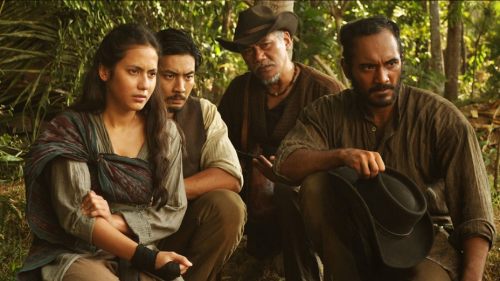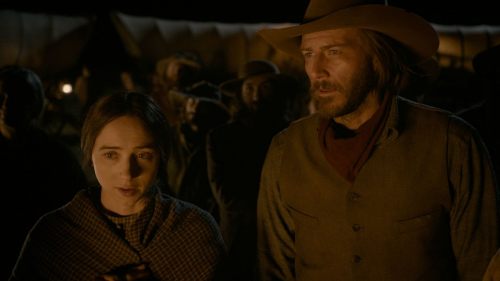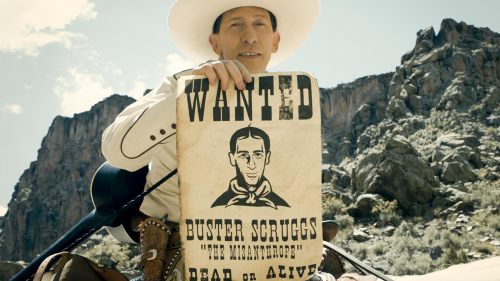THE KEEPING ROOM And Women In Westerns
This month, Drafthouse Films releases Daniel Barber’s The Keeping Room, from the acclaimed 2012 Black List screenplay by Julia Hart. It’s a beautiful, dark, feminist western that follows two sisters (Brit Marling and Hailee Steinfeld) and their slave (Muna Otaru) as they fight for their survival from relentless assailants.
The western genre has long been a place for subverting gender conventions; below are six other films that helped establish this trend.
JOHNNY GUITAR (1954)
Nicholas Ray had a penchant for the disenfranchised. Sandwiched between that iconic haggard teenager in Rebel Without A Cause and Bogie's washed-up straw-man of a screenwriter of In A Lonely Place is Ray’s Johnny Guitar. Instead of a movie star past his prime or a little boy with growing pains, Ray gives us Joan Crawford versus misogyny and slut-shaming. Like a proto-Daniel Plainview, Crawford’s Vienna has a competition in her, and on the cusp of building her empire, it’s undone by any number of men she’s known on her way up to the top. In the titular role, Sterling Hayden is consistently one step behind Vienna, playing catchup both romantically and logistically. He can’t deny his love for her, their history, and yet as a puritanical, petulant macho-man, he can’t ever seem to reconcile her right to do her and whoever else she wants. He flounders while she cries real tears not because she’s a woman, but because she so virulently accepts every choice she makes, whether conflicted or regretful. Vienna reserves her rights even as men fight over her for love and money, never capitulating. “Never seen a woman more like a man,” says one of her employees, and it’s not lost that his boss is out of earshot when he does.
CAT BALLOU (1965)
At the dawn of the Counter Culture movement, it's the mad-capping of a traditional Western that serves up comedy, musical numbers and social commentary with literal gallows humor. 1965’s Cat Ballou is ahead of its time in terms of sexual dynamics and satire that wouldn’t be seen again for a few years, when the voice of the hippie generation, Terry Southern, rewrote Voltaire into an obscene and decidedly anti-establishment sex farce called Candy. Frank Pierson, who would go on to spend decades laying cinematic foundations by writing Cool Hand Luke, Dog Day Afternoon, A Star Is Born and Mad Men, made his feature debut in this horse opera. Lee Marvin, an unabashed tough-guy progressive, won an Oscar for playing an antiquated dinosaur of an Old White Guy, the borderline Republican presidential candidate. In her breakthrough role just a few years before combating everyone’s hangups in Barbarella, Jane Fonda’s title character tricks us all into believing she’s the kind of naive-but-plucky gal that eventually could become a leader of the feminist movement. There’s even a legitimate Greek Chorus by Nat King Cole and Stubby Kaye, lamenting all the potentially unladylike, ramshackle decisions that Cat makes. Cat Ballou takes all the happy-go-lucky casual sexism, racism and ultra-violence so important to the genre for generations and begins to force us to laugh at them, all through a plot that is about industrialization, the end of the gunfighter and, ostensibly, the birth of female enfranchisement, a burgeoning youth movement and liberalism. “There’s a roller rink laid over the OK Corral,” says Marvin’s haggard outlaw, and it’s Fonda’s Cat who might as well strap on her skates.
BUTCH CASSIDY AND THE SUNDANCE KID (1969)
The undisputed most bromantic of the Hollywood New Wave, Butch Cassidy And The Sundance Kid hides its love triangle in plain sight. Katherine Ross’ level-headed schoolteacher-cum-gangmember, Etta Place, often supplies the only voice of reason as Butch and Sundance take their self-destructive relationship on the road. It’s Etta who points out the obvious, that their shenanigans have them hunted, momentarily pausing the homoerotic gunplay long enough to hit the road. Even after being dragged to Bolivia, half on the lam and half in the mood for pie-in-the-sky crimes, it’s Etta who tries, in vain, to teach the boys Spanish. She only jams when their grab-ass for each other makes it painfully obvious neither will survive. Unlike so many Westerns, Etta isn’t subjugated or suppressed so much as taken for granted, with a tacit understanding that she could never be the kind of true-blue spouse that the boys are for one another. Butch and Sundance might be one drink away from flat out wishing they knew how to quit each other, but that’s what keeps Etta’s head screwed on and her hide intact. Unlike Jules and Jim, Butch and Sundance never fight over Etta because they’re so in love with themselves. Her lack of their narcissism and hopeless romance, both as a member of the “Me Generation” and couched in the stoicism of the Old West, results in her being the most Cowboy of them all.
TWO MULES FOR SISTER SARA (1970)
Slogging through this Rape Culture rage-watch is worth it for the last 20 minutes. There’s a reveal that just barely makes up for what we hope was the kind of cynicism and skepticism that led to screenwriter Albert Maltz’s blacklisting as one of the “Hollywood 10,” and leaving star Shirley MacLaine top-billed over Clint Eastwood. Is Two Mules for Sister Sara as subversive and snide as we’d like it to be? If one were into conspiracy theories, we wonder if there was an ongoing political tug-of-war between liberals like MacLaine and Maltz, and reactionary director Don Siegel and his own personal Dirty Harry, Eastwood. Perhaps the tie-breaker was independent Horse Opera godfather Budd Boetticher, who is credited for the story. It wouldn’t be a dream-team of the genre without a Morricone score, which Tarantino lifted in its entirety for Django Unchained. Like a Western version of Looking For Mr. Goodbar, it vacillates between compartmentalizing our heroine and suggesting that she’s the only sane person in a world of bratty boys. MacLaine’s own title character often doesn’t know where she stands, having conversations with Eastwood that include phrases like “I just want to feel safe” and “Everyone's got a right to be a sucker once” in the same breath. This kind of conflict couldn’t have been lost in 1969, although the film feels far less about purposeful, apropos gender politics and more like warring factions amongst the filmmakers. In a movie where our heroine’s duplicity becomes the reason, in retrospect, to watch it, that schism becomes the most interesting aspect.
THE HIRED HAND (1971)
There were swirling, dusty clouds of gasses and elements within cinema for years leading up to it, but Easy Rider was the Big Bang that birthed American filmmaking’s independent vibes, our very own New Wave. Hot off his own heels, Peter Fonda directed The Hired Hand, one of the few films that rivals his own of only a couple years before. Like pal Dennis Hopper’s followup, The Last Movie, and a couple other seminal films of the year (Two-Lane Blacktop, Straw Dogs, Mccabe and Mrs. Miller), Fonda’s directorial debut is an existential relationship drama with just as many questionable choices as there are questions with no answers. Vilmos Zsigmond, cameraman responsible for all your favorite films, and an incredibly apropos and bittersweet score by Bruce Langhorne, perfectly complement Alan Shore’s terse and intense screenplay. In the canon of the American New Wave, it is the preeminent exploration of femininity, redemption and articulation of romance, both between Fonda’s protagonist, his best friend (played by the greatest actor of all time, Warren Oates) and the actual star of the film, the estranged and empowered wife, impeccably performed by Verna Bloom.
It is the emotional infidelity between Fonda and Bloom, and her steadfast, tough, unapologetic tone that make the film so unique and profound. Bloom’s character is a complicated, modern person who is, aptly, very alone in the Wild West. She is, without compunction, in need of companionship, physical and emotional comfort, and unlike the two men who have rode in to her farm, is chastised for it. Concerned with her daughter, her power and independence, it does not conflict with a desire to find emotional presence with her spouse, or the subsequent vulnerability. It is an aspiration we should all have. Tragedy bookends the film, appropriate for the genre, but couched in the loss of love, the true physical escape of a person we adore.
MCCABE & MRS. MILLER (1971)
“I’m a survivor, I’m not gonna give up, I’m not gonna stop, I’m gonna work harder” - Constance Miller, Presbyterian Church, Washington, 1902.
Robert Altman’s Mccabe and Mrs. Miller defines one of the hallmark tropes of the Western. It is a film about success through sheer self-preservation. Set in the Pacific Northwest against the backdrop of a burgeoning town in need of necessities like a saloon and a whorehouse, Warren Beatty’s John McCabe enlists the help of a career prostitute, Julie Christie’s Constance Miller, to manage the latter. She doesn’t simply have the agency we attribute to women today, she is the whole business. While McCabe wallows in his own ambition, his shortcomings and ego, Miller is the staunch, stoic survivor who manages to persevere. From the moment she rolls into town as her own pimp, Miller juxtaposes McCabe's petulance against her own leadership. He drops a raw egg into a glass of whisky while she eats a smorgasbord. He can’t add. She does the books. She struggles against being a has-been, while he’s a never-was. If it weren’t for the macho bullshit and the inherent gender discrepancy, it’d be a story about a master debater and a cunning linguist. She isn’t a hooker with a heart of gold; she’s the bad dystopian bitch, the boss we need to see ourselves through the greyest winter on record.
This was originally published in the September issue of Birth.Movies.Death. magazine. The Keeping Room arrives in theatersTOMORROW. See it this month!



